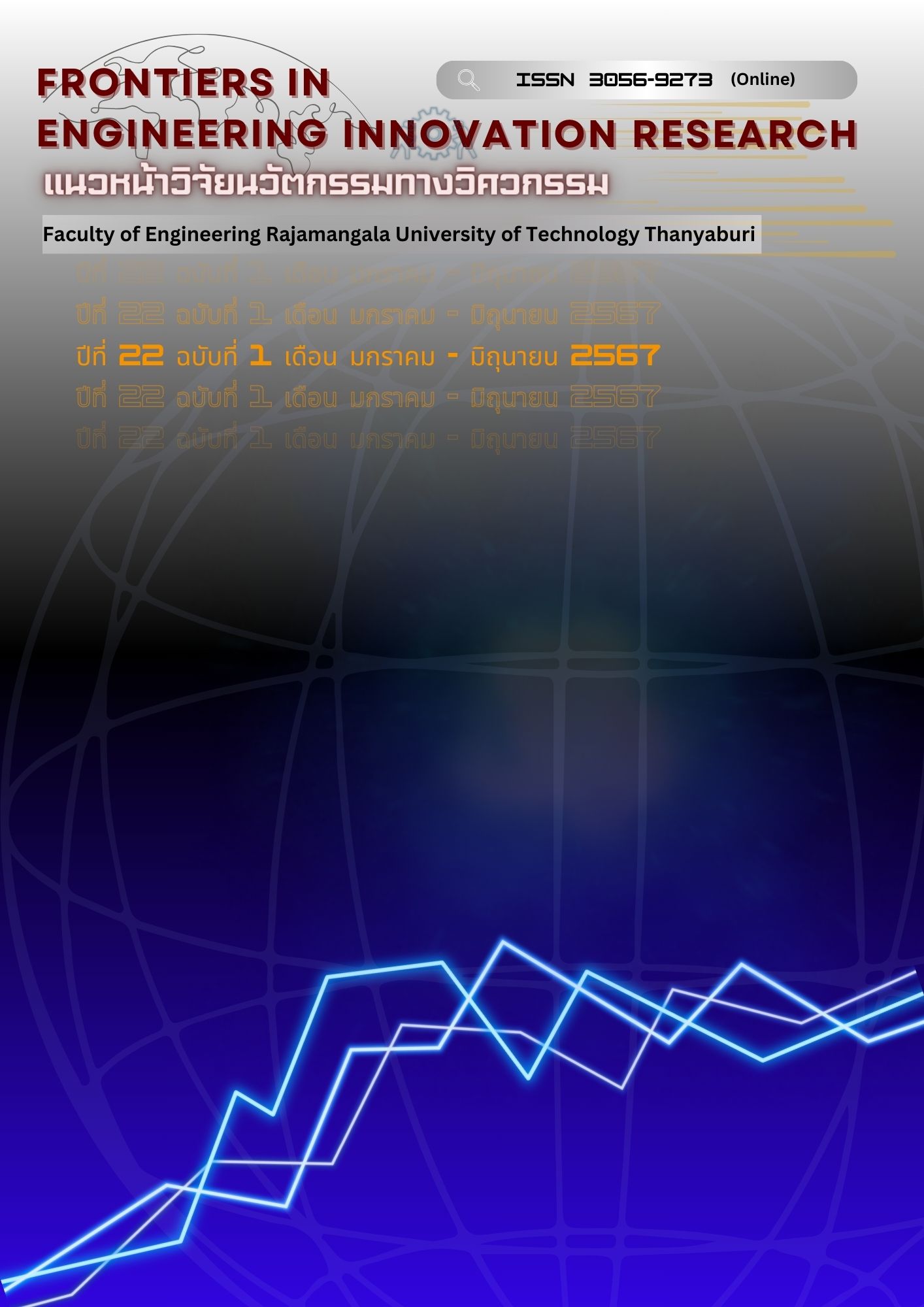The Engineering Properties and Heat Transfer of Concrete Block Mixed with Polystyrene
Main Article Content
Abstract
Study of engineering properties and heat transfer of concrete blocks mixed with plastic waste. Polystyrene replaces sand in the ratios of 0, 5, 10, and 15 percent. The mixing ratio of cement: sand: rock dust is equal to 1: 2: 6 by weight. Water is used in the proportion of 10 percent of the total weight of the mixture. To study engineering properties and heat transfer of concrete Percent absorption value at 7 days and compressive strength of concrete blocks at 7, 14, and 28 days of incubation. Studies have shown that a ratio of 15 percent to polystyrene waste gives the best engineering properties. It has an average density value of 2,258.72 kg/m3. The average water absorption value was equal to 6.49 percent and the average compressive strength at curing ages 7, 14, and 28 were equal to 50.10, 53.16, and 53.73 kg/cm2, respectively, which values were by TIS 58-2017 standards, non-stick type. Bear weight 60-minute heat transfer test using a heat spotlight. T1 (heat emitting side) has an initial temperature of 35 °C. Start recording values. T2 (heat receiving side) records the temperature difference between T1-T2, with the temperature between 35-70 °C. The heat transfer test results of concrete blocks mixed with 15 percent polystyrene plastic waste had a thermal conductivity equal to 3.368 W/m·k. The thermal resistance value is 0.021 m2·k/W. and the heat transfer coefficient of the concrete block is 48.116 W/m2·k. Using polystyrene plastic waste instead of 15 percent sand results in good heat transfer values and is also a guideline for managing plastic waste to be used as construction materials. that can be developed commercially in the future
Article Details

This work is licensed under a Creative Commons Attribution-NonCommercial-NoDerivatives 4.0 International License.
The manuscript, information, content, picture and so forth which were published on Frontiers in engineering innovation research has been a copyright of this journal only. There is not allow anyone or any organize to duplicate all content or some document for unethical publication.
References
Pollution Control Department. Academic publications Roadmap Plastic Waste Management. Ministry of Natural Resources and Environment. 2021. (in Thai)
Paopongpaiboon K, Boonserm K, Chindaprasirt P, Horsakulthai V. The effect of organic solvent patios on mechanical properties and thermal conductivity of walkway block from waste foam residue. The Engineering Institute of Thailand under H.M. The King’s Patronage. 2019;30(4):121-32. (in Thai)
Thai Industrial Standard (TIS). TIS no. 58-2560 Hollow non-loadbearing concrete masonry units. Ministry of Industry (Thailand), 2017.
Standard Test Method for Sieve Analysis of Fine and Coarse Aggregates. ASTM Standard. West Conshohocken, PA, [Internet]. 2019. Available from: www.astm.org: ASTM International. 2019.
Standard Specification for Flow Table for Use in Tests of Hydraulic Cement. ASTM Standard. West Conshohocken, PA, [Internet]. 2019, Available from: www.astm.org: ASTM International, 2014.
Standard Test Method for Density, Absorption, and Voids in Hardened Concrete. ASTM Standard. West Conshohocken, PA, [Internet]. 2019, Available from: www.astm.org: ASTM International, 2013.
Standard Test Method for Compressive Strength of Hydraulic Cement Mortars Using 2-in. [or 50-mm] Cube Specimens. ASTM Standard. West Conshohocken, PA, [Internet]. 2019. Available from: www.astm.org: ASTM International, 2020.
Aljerf L. Effect of thermal-cured hydraulic cement admixtures on the mechanical properties of concrete. Intercom-International Ceramic Review, 2015;64(8):346-56.
Madhu G, Bhunia H, Bajpai P. K, and Chaudhary V. Mechanical and morphological properties of high-density polyethylene and polylactide blends. Journal of Polymer Engineering, 2014;34(9):813-21.
Wang R, Meyer C. Performance of cement mortar made with recycled high impact polystyrene. Cement and Concrete Composites. 2012;34(9):975–81.
Suwansaard A, Kongpun T, Khemkhao M. Properties of mortar composites from plastic waste. Journal of Applied Science and Engineering. 2021;25(1):59-70.
Suwansaard A, Kongpun T, Khemkhao M. Properties of mortars mixed with polystyrene and hemp fiber wastes. Applied Science and Engineering Progress, 2022;15(1):1-11.
Solomon A, Hemalatha G. Experimental investigation of insulated concrete form (ICF) wall panels under quasi-static cyclic load. International Journal of Engineering and Advanced Technology (IJEAT), 2018;8(2):84-8.
Kaya A, KAR F. Properties of concrete containing waste expanded polystyrene and natural resin. Construction and Building Materials. 2016;15(105):572-8.
Bahij S, Omary S, Feugeas F, Faqiri A. Fresh and hardened properties of concrete containing different forms of plastic waste–A review. Waste Management. 2020;113:157-75.


